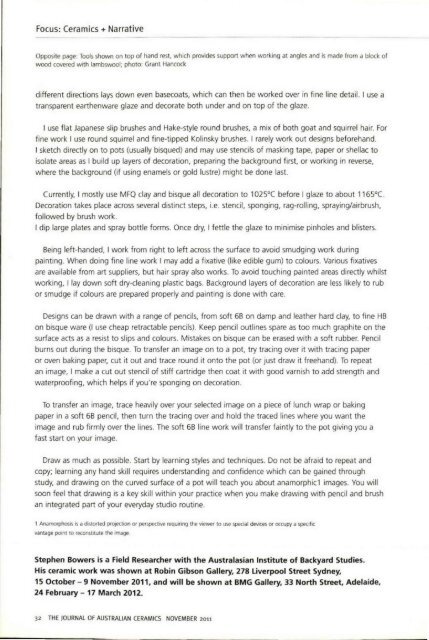The Journal of Australian Ceramics Vol 50 No 3 November 2011
Create successful ePaper yourself
Turn your PDF publications into a flip-book with our unique Google optimized e-Paper software.
Focus: <strong>Ceramics</strong> + Narrative<br />
Opposite page: Tools shown on top <strong>of</strong> hand rest, which provides support when working at angles and is made from a block <strong>of</strong><br />
wood covered with lambswool; photo: Grant Hancock<br />
different directions lays down even basecoats, which can then be worked over in fine line detail. I use a<br />
transparent earthenware glaze and decorate both under and on top <strong>of</strong> the glaze.<br />
I use flat Japanese slip brushes and Hake-style round brushes, a mix <strong>of</strong> both goat and squ irrel ha ir. For<br />
fine work I use round squirrel and fine-tipped Kolinsky brushes. I rarely work out designs beforehand.<br />
I sketch directly on to pots (usually bisqued) and may use stencils <strong>of</strong> masking tape, paper or shellac to<br />
isolate areas as I build up layers <strong>of</strong> decoration, preparing the background first, or working in reverse,<br />
where the background (if using enamels or gold lustre) might be done last.<br />
Currently, I mostly use MFQ clay and bisque all decoration to 1025°C before I glaze to about 1165°C.<br />
Decoration takes place across several distinct steps, i.e. stencil, sponging, rag-rolling, spraying/airbrush,<br />
followed by brush work.<br />
I dip large plates and spray bottle forms. Once dry, I fettle the glaze to minimise pinholes and blisters.<br />
Being left-handed, I work from right to left across the surface to avoid smudging work during<br />
painting. When doing fine line work I may add a fixative (like edible gum) to colours. Various fixatives<br />
are available from art suppliers, but hair spray also works. To avoid touching painted areas directly whilst<br />
working, I lay down s<strong>of</strong>t dry-cleaning plastic bags. Background layers <strong>of</strong> decoration are less likely to rub<br />
or smudge if colours are prepared properly and painting is done with care.<br />
Designs can be drawn with a range <strong>of</strong> pencils, from s<strong>of</strong>t 6B on damp and leather hard clay, to fine HB<br />
on bisque ware (I use cheap retractable pencils). Keep pencil outlines spare as too much graphite on the<br />
surface acts as a res ist to slips and colours. Mistakes on bisque can be erased with a s<strong>of</strong>t rubber. Pencil<br />
burns out during the bisque. To transfer an image on to a pot, try tracing over it with tracing paper<br />
or oven baking paper, cut it out and trace round it onto the pot (or just draw it freehand). To repeat<br />
an image, I make a cut out stencil <strong>of</strong> stiff cartridge then coat it with good varnish to add strength and<br />
waterpro<strong>of</strong>ing, which helps if you're sponging on decoration.<br />
To transfer an image, trace heavily over your selected image on a piece <strong>of</strong> lunch wrap or baking<br />
paper in a s<strong>of</strong>t 6B pencil, then turn the tracing over and hold the traced lines where you want the<br />
image and rub firmly over the lines. <strong>The</strong> s<strong>of</strong>t 6B line work will transfer faintly to the pot giving you a<br />
fast start on your image.<br />
Draw as much as possible. Start by learning styles and techniques. Do not be afraid to repeat and<br />
copy; learning any hand skill requires understanding and confidence which can be gained through<br />
study, and drawing on the curved surface <strong>of</strong> a pot will teach you about anamorphic1 images. You will<br />
soon feel that drawing is a key skill within your practice when you make drawing with pencil and brush<br />
an integrated part <strong>of</strong> your everyday studio routine.<br />
1 Anamorphosis is a distorted projectIOn or perspective requiring the viewer to use s.pedal deviCes or occupy a SpecIfIC<br />
vantage point 10 reconstitute the image<br />
Stephen Bowers is a Field Researcher with the Australasian Institute <strong>of</strong> Backyard Studies.<br />
His ceramic work was shown at Robin Gibson Gallery, 27B Liverpool Street Sydney,<br />
15 October - 9 <strong>No</strong>vember <strong>2011</strong>, and will be shown at BMG Gallery, 33 <strong>No</strong>rth Street, Adelaide,<br />
24 February - 17 March 2012.<br />
32 THE JOURNAL OF AUSTRALIAN CERAMICS NOVEMBER <strong>2011</strong>

















